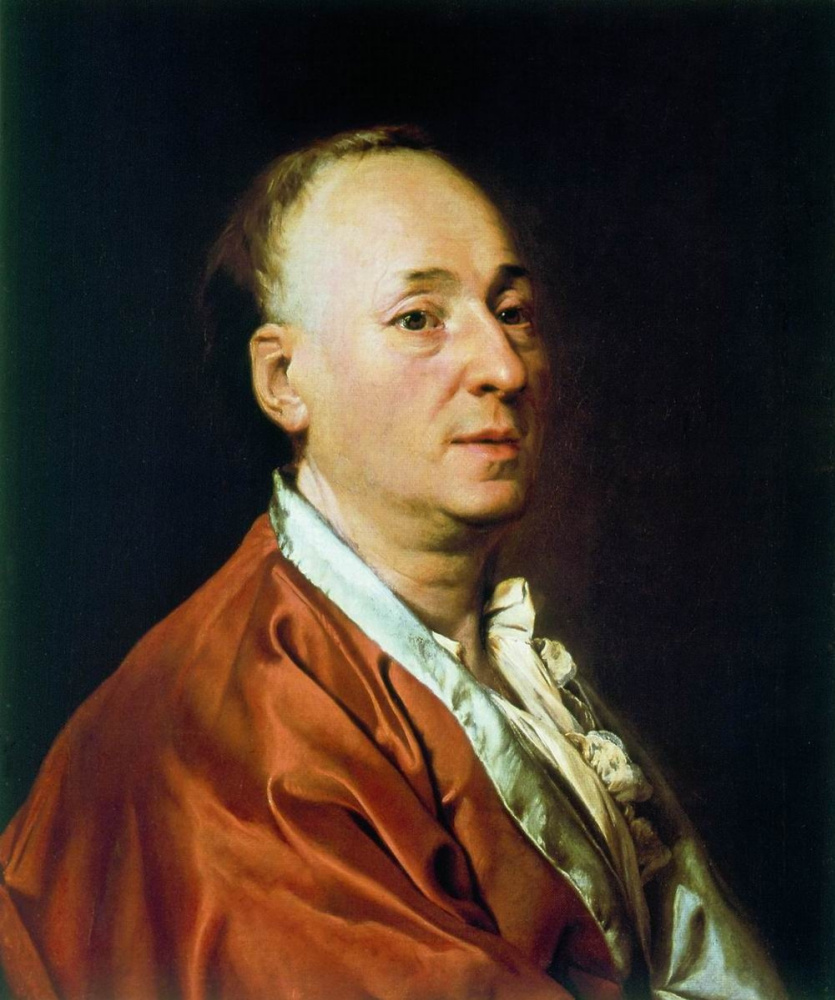log in
Enter site
Login to use Arthive functionality to the maximum
Portrait Of Denis Diderot
Dmitry Grigorievich Levitsky • Painting, 1773
Description of the artwork «Portrait Of Denis Diderot»
Denis Diderot, a prominent theorist of art and knowing a lot about art, did not like their own portraits: "I have a hundred different faces, and they change throughout the day. My face always cheating artists". However, while in Russia, Diderot still agreed to pose for the portraitist Dmitry Levitsky at the house of Prince Naryshkin, where he stayed in St. Petersburg.
Levitsky took the face of a philosopher coarsely and not embellish the shortcomings – bags under the eyes, double chin, and high hairline. He portrayed Diderot "at home" in a satin robe without a mandatory in the 70-ies of the XVIII century wig.
Why the Frenchman Diderot meant so much to Russia?
French philosopher and playwright Denis Diderot was especially favored by the Empress: Catherine II not only could converse with Diderot for hours, but gave him a large sum, which the illuminator was supposed to spend on their own library.
"Diderot", as they said in Russia the name of philosopher, was in correspondence with the Empress and gave her valuable advice about the state of the device. Although Denis Diderot, with Voltaire, d'alembert and Montesquieu and prepared their activities to the bourgeois revolution, the ideal form of government he believed enlightened absolutism, which, of course, could not fail to impress Catherine.
Poet Alexei Konstantinovich Tolstoy that paints the situation:
"Madame, at you splendidly
Order will blossom!" -
Write to her politely Voltaire and Diderot...
However, to persuade Catherine to liberal reforms educator failed.
"Failure" of the portrait at Sotheby's
"Portrait of Diderot" was in the collection of Prince Golitsyn and later the Rothschilds. In the Swiss Museum of art and history (Geneva), where it is now, the picture came in 1997, through the London auction Sotheby's. And Russian observers are of the antique market was very disappointed by this fact.
The fact that exhibited at the same auction rather ordinary in execution "The Evangelist John" Frans Hals (belonging to the collection of Catherine II, but in the 20-ies of XX century removed from the country) went for 1.7 million pounds, whilst much more artistic and historically valuable "Portrait of Diderot" of only 52 thousand.
The magazine "Spark," then complained that the West is not sufficiently interested in Russian artists and encouraged to enjoy the moment and the low prices, to expensive to buy out our heritage for the collections of Russian museums.
A philosopher or "Yeller"?
However, not all unequivocally agree that this portrait has so much unconditional artistic value. Even Alexander Benois, highly appreciated Levitsky (and in the early twentieth century re-discovered the almost forgotten artist to the General public), says, however, that Levitsky sometimes lacked depth and detail. And this confirms your idea is just a "Portrait of Diderot":"He (Levitsky) was simple, with a hint of harmless cunning man, but was not a profound man; portraying Diderot, he tried to emphasize to him "Yeller", but it took a little a huge mind of a philosopher..."
Author: Anna Yesterday
Levitsky took the face of a philosopher coarsely and not embellish the shortcomings – bags under the eyes, double chin, and high hairline. He portrayed Diderot "at home" in a satin robe without a mandatory in the 70-ies of the XVIII century wig.
Why the Frenchman Diderot meant so much to Russia?
French philosopher and playwright Denis Diderot was especially favored by the Empress: Catherine II not only could converse with Diderot for hours, but gave him a large sum, which the illuminator was supposed to spend on their own library.
"Diderot", as they said in Russia the name of philosopher, was in correspondence with the Empress and gave her valuable advice about the state of the device. Although Denis Diderot, with Voltaire, d'alembert and Montesquieu and prepared their activities to the bourgeois revolution, the ideal form of government he believed enlightened absolutism, which, of course, could not fail to impress Catherine.
Poet Alexei Konstantinovich Tolstoy that paints the situation:
"Madame, at you splendidly
Order will blossom!" -
Write to her politely Voltaire and Diderot...
However, to persuade Catherine to liberal reforms educator failed.
"Failure" of the portrait at Sotheby's
"Portrait of Diderot" was in the collection of Prince Golitsyn and later the Rothschilds. In the Swiss Museum of art and history (Geneva), where it is now, the picture came in 1997, through the London auction Sotheby's. And Russian observers are of the antique market was very disappointed by this fact.
The fact that exhibited at the same auction rather ordinary in execution "The Evangelist John" Frans Hals (belonging to the collection of Catherine II, but in the 20-ies of XX century removed from the country) went for 1.7 million pounds, whilst much more artistic and historically valuable "Portrait of Diderot" of only 52 thousand.
The magazine "Spark," then complained that the West is not sufficiently interested in Russian artists and encouraged to enjoy the moment and the low prices, to expensive to buy out our heritage for the collections of Russian museums.
A philosopher or "Yeller"?
However, not all unequivocally agree that this portrait has so much unconditional artistic value. Even Alexander Benois, highly appreciated Levitsky (and in the early twentieth century re-discovered the almost forgotten artist to the General public), says, however, that Levitsky sometimes lacked depth and detail. And this confirms your idea is just a "Portrait of Diderot":"He (Levitsky) was simple, with a hint of harmless cunning man, but was not a profound man; portraying Diderot, he tried to emphasize to him "Yeller", but it took a little a huge mind of a philosopher..."
Author: Anna Yesterday


